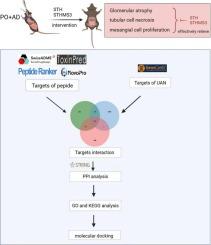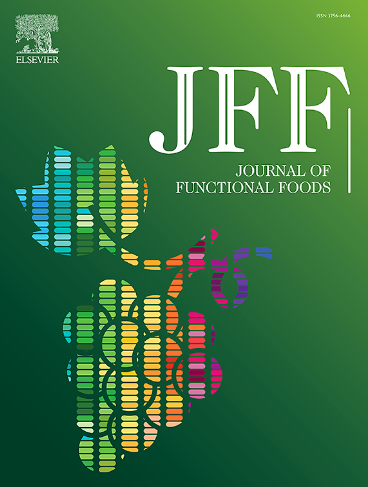整合多层次交互式网络分析和体内研究,探索鲣鱼胰蛋白酶水解产物对高尿酸血症的保护机制
IF 3.8
2区 农林科学
Q2 FOOD SCIENCE & TECHNOLOGY
引用次数: 0
摘要
本研究使用鲣鱼副产品生产鲣鱼胰蛋白酶水解物(STH),然后通过马氏反应(Maillard reaction)处理生成其马氏产物 STHMS3(200-1000 Da)。我们评估了 STHMS3 对高尿酸血症诱发的小鼠肾损伤的保护作用。利用体内实验、网络药理学和分子对接,我们探索了其保护机制。STHMS3 能明显降低血清尿酸、肌酐、血尿素氮和黄嘌呤氧化酶(XOD)的水平,减少氧化应激,提高肾脏中抗氧化蛋白的水平。网络药理学分析表明,STHMS3与多个靶点和通路相互作用,包括细胞凋亡、NF-κB和TNF信号通路,表明其具有多层次的交互网络机制。分子对接证实 STHMS3 能够通过氢键形成直接抑制 XOD。这项研究凸显了食物源肽在控制高尿酸血症和保护肾功能方面的治疗潜力。本文章由计算机程序翻译,如有差异,请以英文原文为准。

Integrating multi-level interactive network analysis and in vivo studies to explore the protective mechanism of Maillard products of skipjack trypsin hydrolysate in hyperuricemia
This study used skipjack by-products to produce skipjack trypsin hydrolysate (STH), which was then processed through the Maillard reaction to create its Maillard product, STHMS3 (200–1000 Da). We evaluated STHMS3's protective effects against hyperuricemia-induced renal injury in mice. Utilizing in vivo experiments, network pharmacology, and molecular docking, we explored its protective mechanisms. STHMS3 significantly decreased serum uric acid, creatinine, blood urea nitrogen, and xanthine oxidase (XOD) levels, reduced oxidative stress, and enhanced antioxidant protein levels in kidneys. Network pharmacology analysis showed STHMS3's interaction with multiple targets and pathways, including apoptosis, NF-κB, and TNF signaling pathways, suggesting a multi-level interactive network mechanism. Molecular docking confirmed STHMS3's ability to directly inhibit XOD through hydrogen bond formation. This study highlights the therapeutic potential of food-derived peptides in managing hyperuricemia and protecting renal function.
求助全文
通过发布文献求助,成功后即可免费获取论文全文。
去求助
来源期刊

Journal of Functional Foods
FOOD SCIENCE & TECHNOLOGY-
CiteScore
9.60
自引率
1.80%
发文量
428
审稿时长
76 days
期刊介绍:
Journal of Functional Foods continues with the same aims and scope, editorial team, submission system and rigorous peer review. We give authors the possibility to publish their top-quality papers in a well-established leading journal in the food and nutrition fields. The Journal will keep its rigorous criteria to screen high impact research addressing relevant scientific topics and performed by sound methodologies.
The Journal of Functional Foods aims to bring together the results of fundamental and applied research into healthy foods and biologically active food ingredients.
The Journal is centered in the specific area at the boundaries among food technology, nutrition and health welcoming papers having a good interdisciplinary approach. The Journal will cover the fields of plant bioactives; dietary fibre, probiotics; functional lipids; bioactive peptides; vitamins, minerals and botanicals and other dietary supplements. Nutritional and technological aspects related to the development of functional foods and beverages are of core interest to the journal. Experimental works dealing with food digestion, bioavailability of food bioactives and on the mechanisms by which foods and their components are able to modulate physiological parameters connected with disease prevention are of particular interest as well as those dealing with personalized nutrition and nutritional needs in pathological subjects.
 求助内容:
求助内容: 应助结果提醒方式:
应助结果提醒方式:


